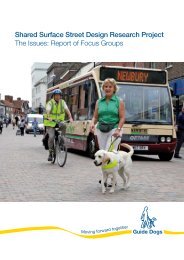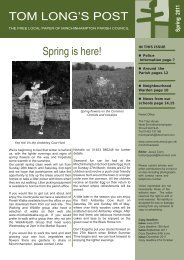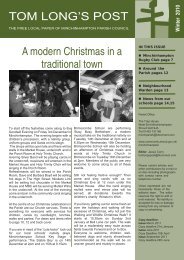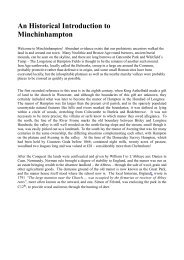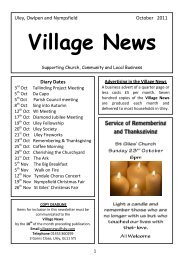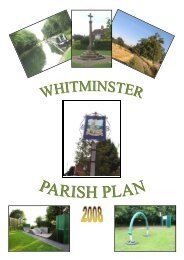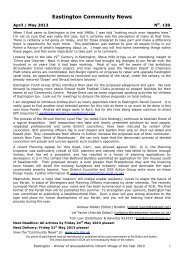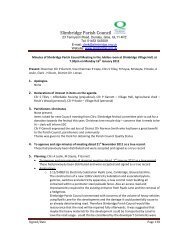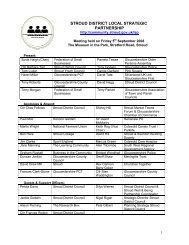Eastington Community News - Stroud District Community Websites
Eastington Community News - Stroud District Community Websites
Eastington Community News - Stroud District Community Websites
Create successful ePaper yourself
Turn your PDF publications into a flip-book with our unique Google optimized e-Paper software.
Developments During the Demolitions at Millend Mill - Pt 2<br />
Since my first note in the previous newsletter, and as anyone passing the mill will have<br />
noticed, developments at Millend have continued to move at a pace. Demolition of the<br />
various buildings joined to the main mill has gone ahead, and much of the site has now<br />
been cleared. As before, various interesting things have come to light. Equally, there are<br />
even more puzzles. Briefly:<br />
The single storey building along Cress Green lane has been demolished, and more recently,<br />
the concrete slab on which it stood, broken up and removed. Along with an archaeologist<br />
from Cotswold Archaeology, I waited with interest to see what might be beneath it. Several<br />
things appeared. The first was two linked deep brick chambers that appear to have once<br />
formed some form of drainage system, perhaps from cottages that once stood on the<br />
hillside. And closer to the mill, the footings of a stone-built wall appeared in what would<br />
have been the middle of the (now demolished) building. This was made up of several<br />
courses of rectangular limestone blocks surmounted with a course of re-used pieces –<br />
some were clearly stone window mouldings, probably from some long gone part of the mill.<br />
There was no indication of the wall’s function, so along with the drainage chambers, it was<br />
photographed, recorded and removed. The whole area has now been covered with crushed<br />
rubble as hard core for the two new houses to be built there.<br />
On the opposite side of the river, all of the newer buildings tacked on to the mill were also<br />
demolished, not without some difficulty. The section where the large steel roller door was<br />
located proved to be particularly tough! Nevertheless, this, as well as the adjoining parts<br />
disappeared over the course of a few days. Even this unremarkable looking building proved<br />
to be more interesting than it might have been. The upper floor had once been lit by rows<br />
of windows (long bricked up), so clearly, this building was more than a simple loading bay<br />
when it was originally built. Local information suggested that it may have been added<br />
during the 1950s. However, a steel fire door that originally linked it with the adjoining<br />
earlier two-storey brick building had a different story to tell. Under many layers of paint<br />
was a maker’s plate. This was removed and carefully cleaned, revealing that the door had<br />
come from a Manchester supplier and was dated ‘August 1945’. So, clearly, this ‘modern’<br />
building was older than thought and dated back to at least the 1940s if not earlier.<br />
Unfortunately, there were no indications as to what it was originally built for.<br />
Once these ‘newer’ buildings had gone, the earlier two-storey building alongside the river<br />
was fully revealed. This disappeared at a remarkable rate and I was hard pushed to keep<br />
up with the demolition crew! Even though it had been bodged up and altered many times<br />
over the years, it still managed to reveal things of interest. Both floors of the building had<br />
originally been lit using numerous large iron-framed round-headed windows. When this was<br />
built (1820s-30s), local cloth mill owners were busy gathering in hand loom weavers from<br />
their cottages, and much to the latter’s disgust, grouping them together in specialised loom<br />
shops. This meant that the owners could now regulate their hours of work and monitor the<br />
quality of the cloth they produced. Looms took up a lot of space and needed a lot of natural<br />
daylight, hence the large windows. Perceived wisdom suggested that this building had<br />
never housed powered machinery. However, there were various indications that this was<br />
not the case, and that some form of activity requiring power from either the water wheels<br />
or the steam engine had taken place (although we can’t be sure at what period). Some of<br />
the roof trusses removed during demolition had once carried bearing housings for line<br />
shafting, and several beams also showed where the oil used to lubricate them had seeped<br />
into the wood. At a guess, I would suggest that this may have been connected with the<br />
mill’s later time as a corn mill, rather than earlier cloth manufacture.<br />
Continued/<br />
No article of part thereof may be reproduced or published without prior permission of the Editor and author.<br />
The views expressed in ECN are not necessarily those of the editor.<br />
4



